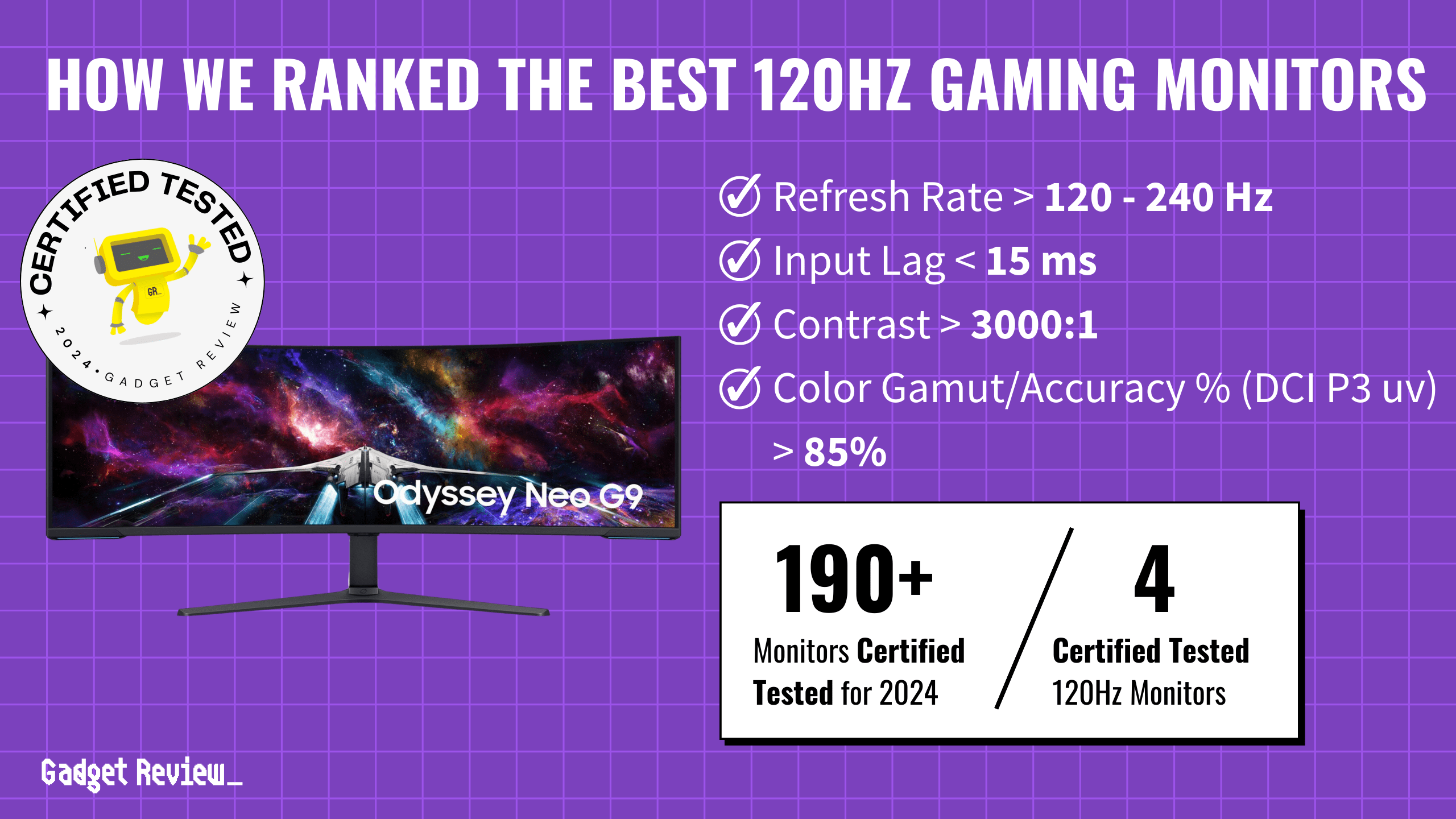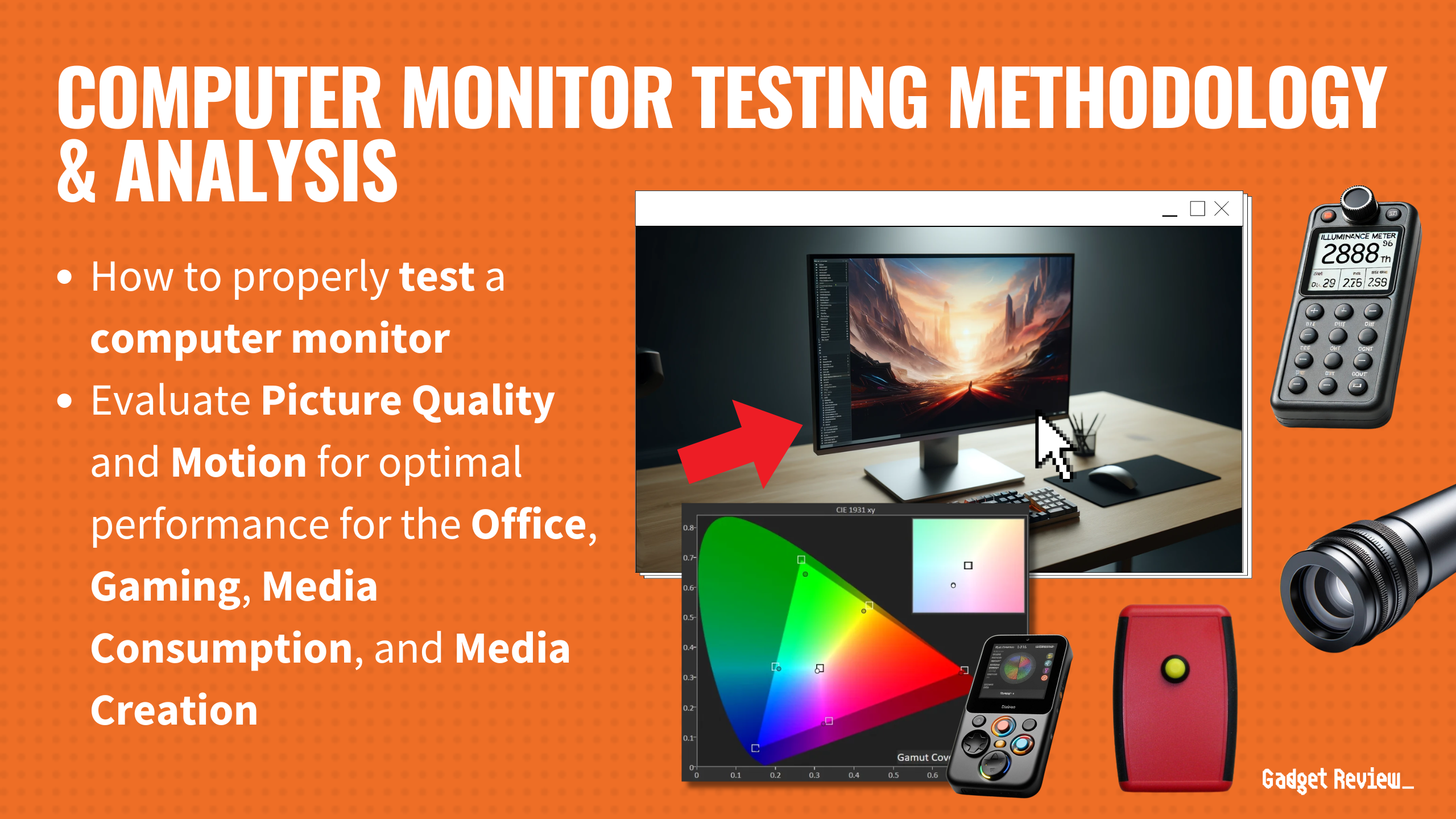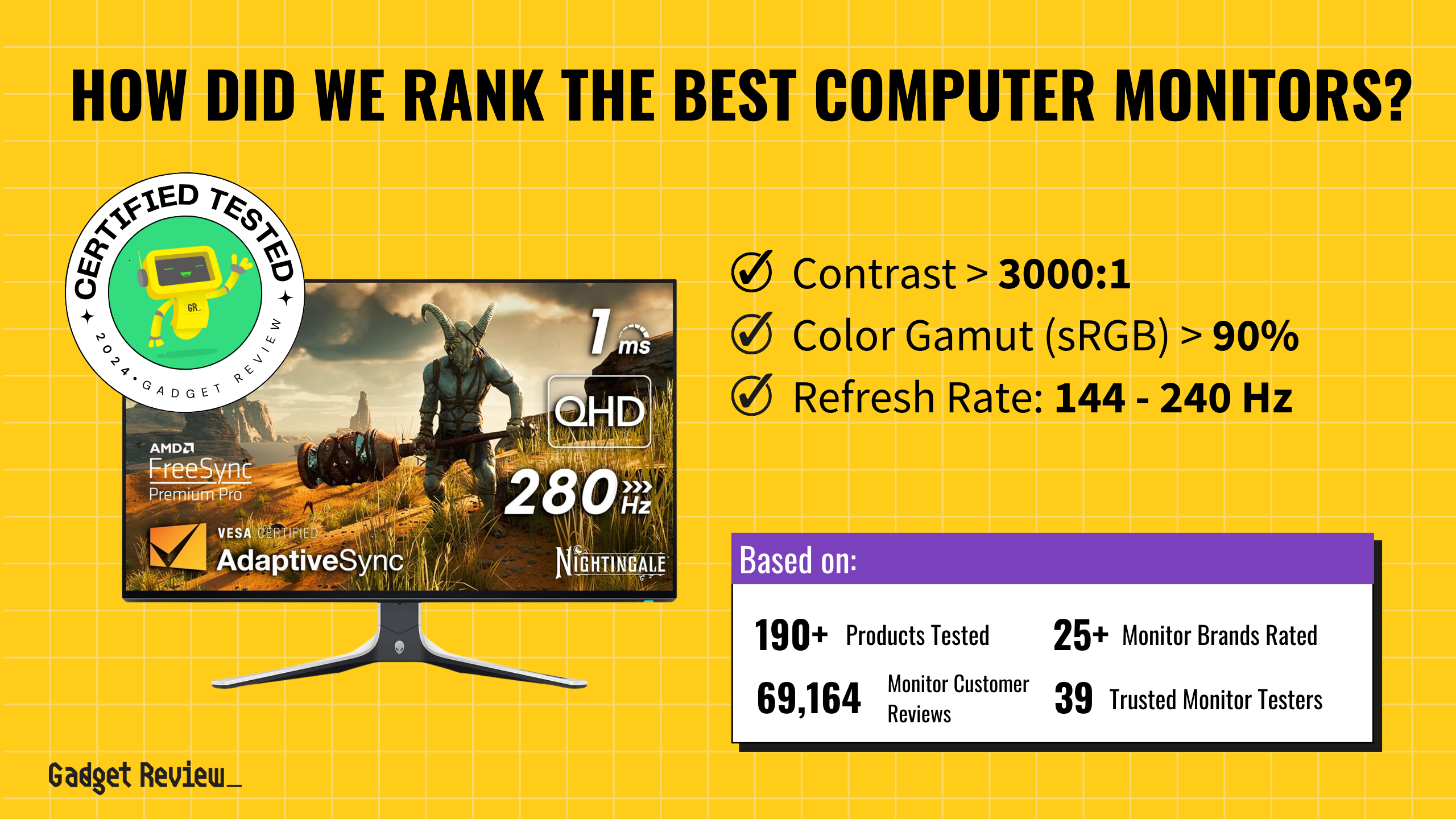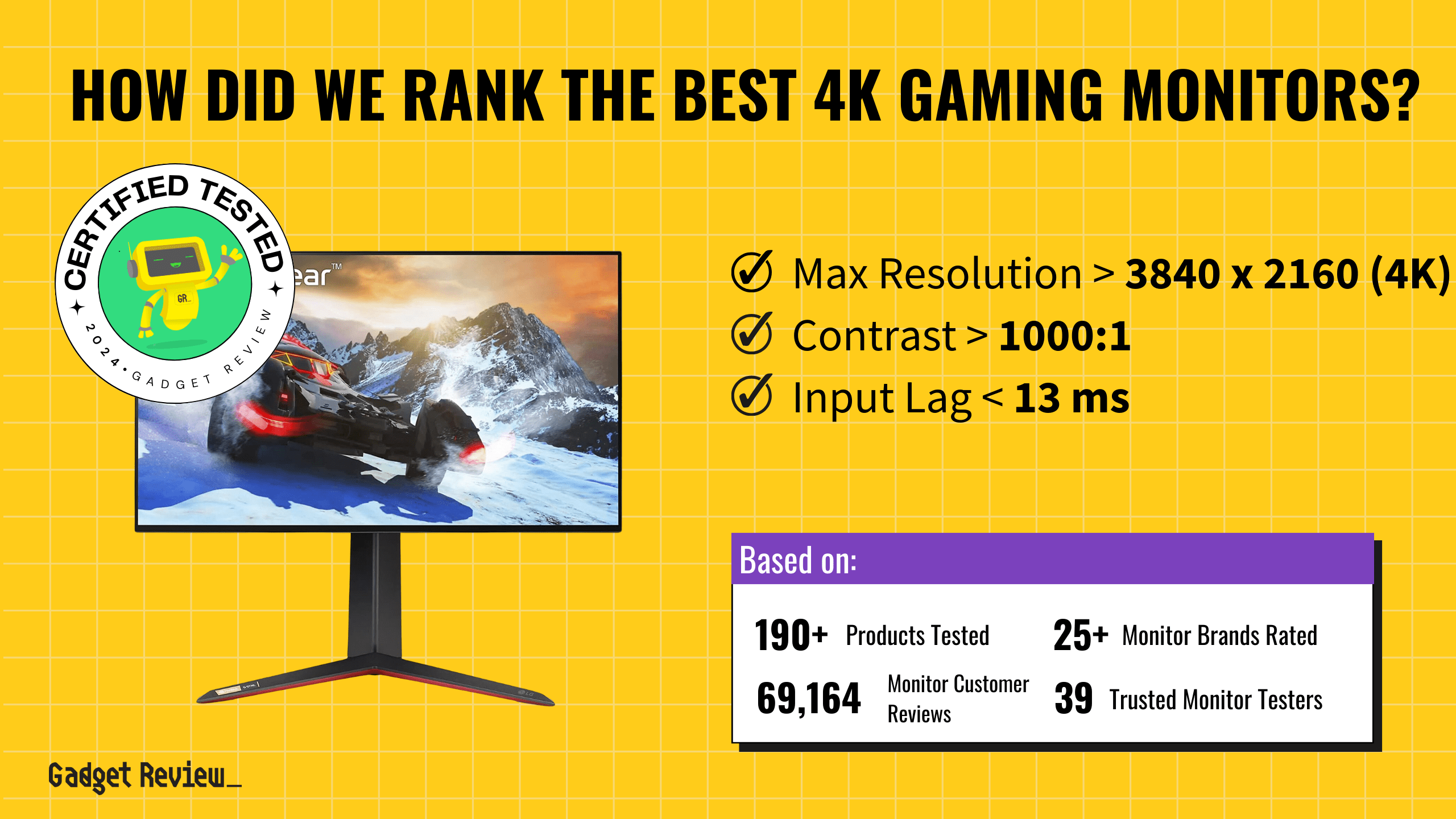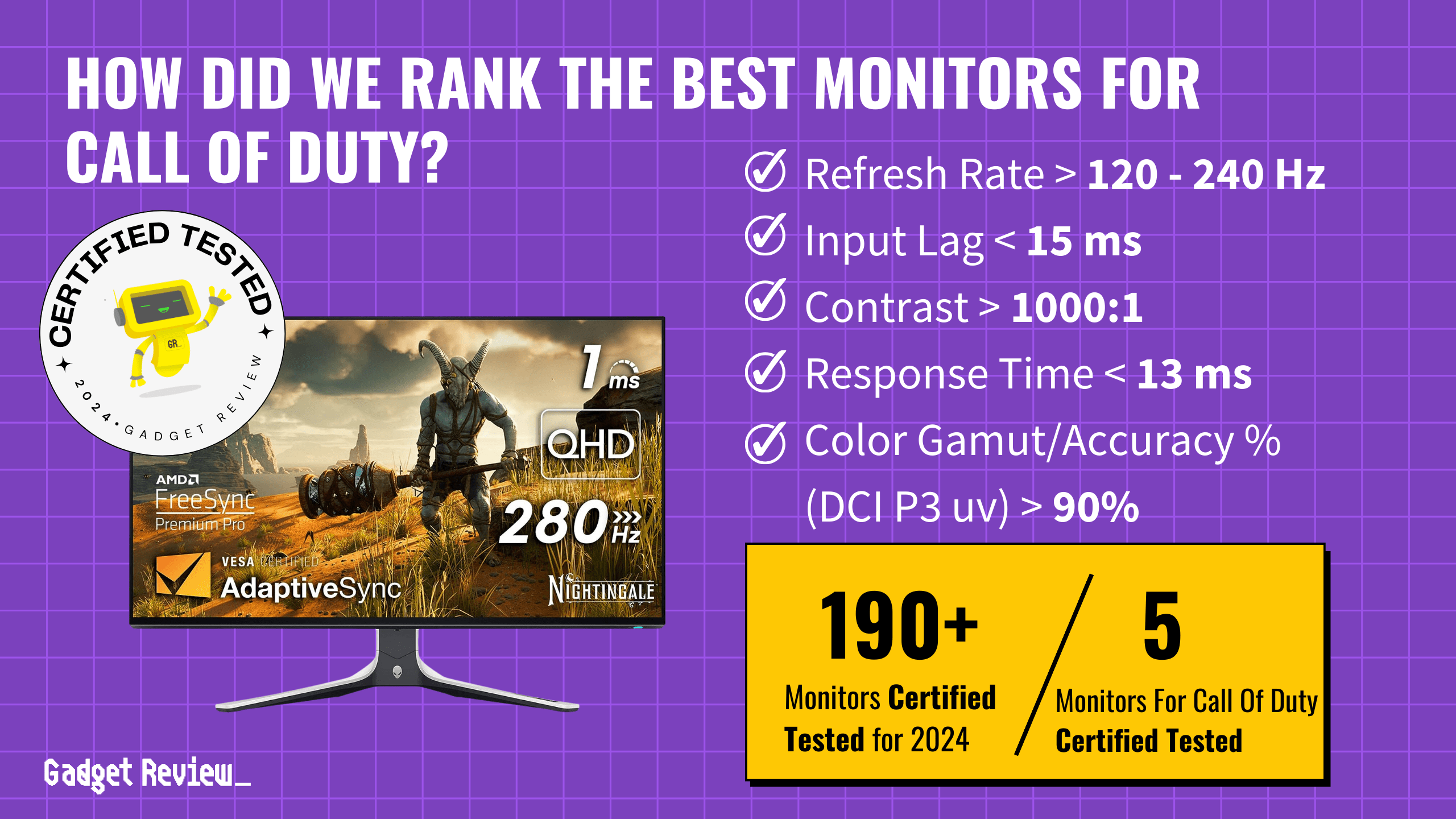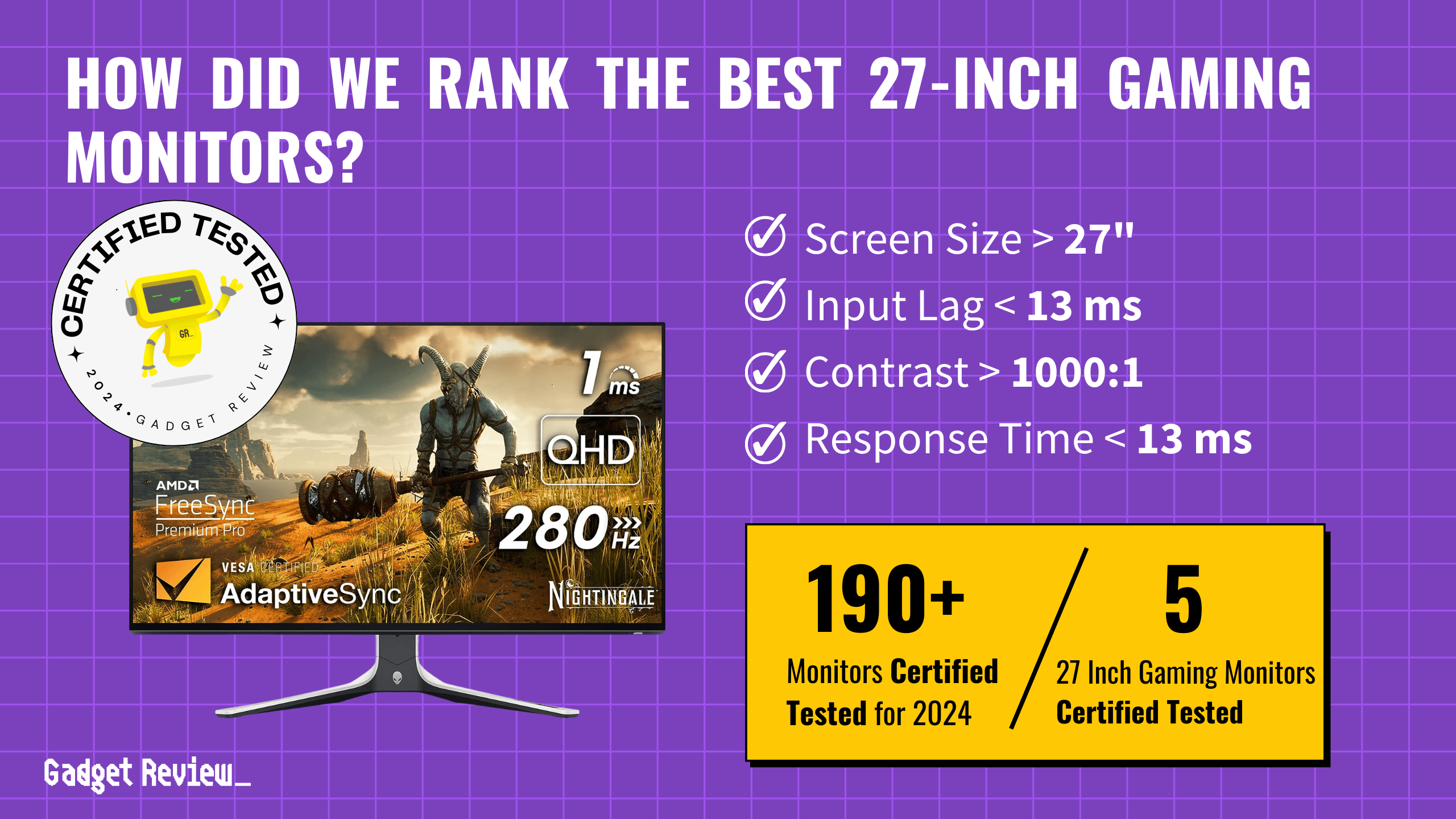When you’re looking for the best 120Hz gaming monitors, it’s crucial to focus on image quality, response time, and input lag. These monitors should deliver excellent brightness, accurate color gamut, and a contrast ratio over 1000:1. A low response time reduces motion blur, enhancing gameplay, while low input lag ensures your actions translate immediately on screen.
In our analysis, four gaming monitors excelled. We examined 196 models, certified them as tested, and reviewed 319,930 customer reviews. Unfortunately, 71% of expert reviews weren’t trustworthy. Using True Score and Trust Score, we filtered out the fake and low quality reviews to spotlight the top performers. These monitors offer smooth, responsive gameplay, making them the best choices for gamers.
For even faster refresh rates, the best 240Hz gaming monitors deliver unmatched responsiveness for competitive gamers, while 144Hz gaming monitors offer a sweet spot between smoothness and cost-effectiveness. Additionally, these great monitors balance performance and features to cater to different needs and preferences.
How Did We Rank the Best 120Hz Gaming Monitors?
To determine the best 120Hz gaming monitors, Gadget Review’s experts conducted an in-depth analysis of more than 200 websites, covering testing procedures, customer feedback, and expert reviews. This thorough investigation allowed us to isolate the 2 critical test outcomes, 1 additional beneficial features, and 2 vital specifications. Our buying guide, grounded in our True Score system, highlights the top monitors, ensuring you achieve optimal gaming performance.
Our commitment to unbiased reviews is powered by our ‘True Score’ system, targeting low quality and fake reviews. When you shop through our links, you’re backing our mission. Dive deeper to see how.
?️ Minimum Specifications
- Must have a refresh rate of 120Hz or higher
- Must have support for AMD FreeSync or NVIDIA G-Sync
? Test Criteria
- Input Lag: An input lag of less than 15 milliseconds ensures a highly responsive gaming experience with minimal delay between action and on-screen response.
- Contrast Ratio: 1300:1 or higher (infinite), offering deep blacks and bright whites for an exceptional viewing experience.
? “Nice To Haves”
- Color Accuracy: At least 85% of the DCI P3 color gamut, providing rich and vibrant colors.
Latest Updates
- 05/04/2024: Republished the list to include the best 120Hz gaming monitors based on our True Score system.
Top 120Hz Gaming Monitors For 2025
Prices accurate at the time of publishing

Best Overall

Runner Up

Best Value

Best Budget

Best Mid-Range

Premium Pick
Dell S3422DWG
The Dell S3422DWG’s low input lag and high performance won’t disappoint for an exceptional, versatile mid-range curved ultrawide 120 Hz monitor.
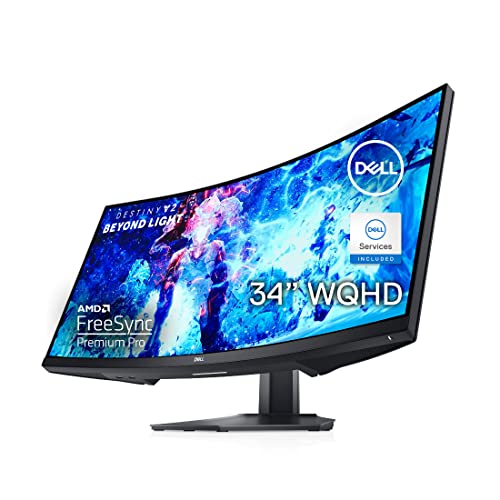
True Score
84824Experts
916kCustomers
Absolutely Fresh
 SAVE $51$399.99$349.00
SAVE $51$399.99$349.00Snapshot
Reasons to Buy
- Outstanding input lag
- Excellent response time at the maximum refresh rate
- Large screen with a crisp resolution
Reasons to Avoid
- Narrow viewing angles
- Some black smearing in dark scenes
- Buggy G-SYNC compatibility at frame rates below 60 fps
Specifications
Display Type VA HDMI Inputs 2 HDR Format Yes Max Resolution 3440 × 1440 
Panel Type VA Refresh Rate 144 Hz 
Response Time 2 ms Screen size 34″ 
Sync Technology AMD FreeSync All Specs
Test Results
Brightness (nits) 413 Contrast Ratio (as ratio x:1) 3,008 Color Gamut/Accuracy % (DCI P3 xy) 87 Color Gamut/Accuracy % (DCI P3 uv) 0 Color Gamut % (sRGB Coverage xy) 99 Color Gamut % (Adobe RGB Coverage xy) 83 All Retailers
- $349.00$400Save $51
Availability
In StockFree Shipping
Yes - $396.74$510Save $113
Availability
In StockFree Shipping
No
Our Verdict
If you are looking for a curved ultrawide gaming monitor without paying a premium, the Dell S3422DWG is an excellent mid-range option. This monitor boasts a class-leading input lag of just 4.5 ms and a swift response time of 6.9 ms, ensuring that every in-game action is as quick as your reactions. These specifications are crucial for gamers, as they significantly enhance the smoothness and responsiveness of the gaming experience, particularly in fast-paced titles where each millisecond is critical.
With a peak brightness of 413 nits and covering 98.5% of the sRGB color spectrum, this monitor is fantastic for gaming and consuming or creating content. It features a high contrast ratio of 3008:1, less than the 4692:1 of another curved ultrawide, the Samsung Odyssey Neo G9. Nevertheless, the Dell S3422DWG delivers deep blacks and vivid colors, elevating the visual quality of both games and films. The 120 Hz refresh rate and 3440 × 1440 resolution, alongside FreeSync compatibility, ensure a smooth and uninterrupted gaming experience across various game genres.
Moreover, the Dell S3422DWG is highly versatile, excelling in other applications such as watching TV shows and movies and even in productivity and content creation tasks. Its ultrawide aspect ratio and high resolution provide extensive screen space, facilitating multitasking and immersion. The monitor’s performance in terms of brightness, color accuracy, and contrast ratio also makes it appealing to movie buffs and content creators who value color fidelity and image clarity. Its wide-ranging capabilities make it a valuable addition to any setup, extending its use beyond gaming to entertainment and productivity.
Category Snapshot
Computer Monitors
- Total Brands/Products Tested
27 Brands, 196 Products
- Top 2 Brands
Dell, HP
- Price Range (Budget-Premium)
$100-$1,500
- Average True Score
74.46
- Important Test Criteria
Brightness (cd/m2)
Contrast Ratio (1000:1) - Most Trusted Testers

- Top Monitor Experts
- Typical Warranty
2 years
- Covered by Insurance
Yes – AKKO

Best Overall

Runner Up

Best Value

Best Budget

Best Mid-Range

Premium Pick
Corsair Xeneon 27QHD240
Best For Xbox One X
The Corsair Xeneon 27QHD240, with its superb OLED panel and near-instantaneous response time, excels as a versatile and premium 120 Hz gaming monitor.
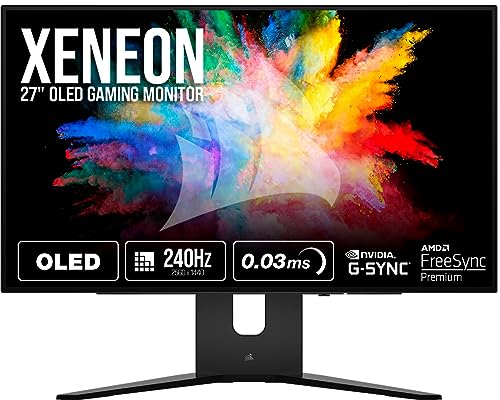
True Score
848310Experts
90336Customers
Absolutely Fresh
 SAVE $250$999.99$749.99
SAVE $250$999.99$749.99Snapshot
Reasons to Buy
- Excellent OLED Picture Quality
- Ultra-Fast Response Time
- Low Input Lag
- High Refresh Rate and VRR Support
Reasons to Avoid
- Lower Peak Brightness Levels
- Higher Input Lag with Different Refresh Rates
- Potential OLED Burn-In
Specifications

Available Inputs 3.5mm, DisplayPort, HDMI, USB 
Bluelight Filter Yes 
Built-In Speakers No 
Built-In Webcam No 
Curved Screen No Display Type OLED 
Flicker Free Yes HDMI Inputs 2 HDR Format HDR10 High Dynamic Range (HDR) Yes Max Resolution 2560 x 1440 
Panel Type OLED Refresh Rate 240 Hz 
Response Time 0.03 ms 
Rotating Screen Yes Screen size 27″ 
Sync Technology AMD FreeSync, G-Sync All Specs
Test Results
Brightness (nits) 318 Contrast Ratio (as ratio, x:1) 9,473 Color Gamut/Accuracy % (DCI P3 xy) 96 Color Gamut/Accuracy % (DCI P3 uv) 0 Color Gamut % (Adobe RGB Coverage xy) 90 Color Gamut % (sRGB Coverage xy) 107 All Retailers
- $749.99$1,000Save $250
Availability
In StockFree Shipping
Yes - $999.99
Availability
Free Shipping
Yes - $1,103.65
Availability
In StockFree Shipping
No
Our Verdict
For those looking for a top-tier 120 Hz gaming monitor that doesn’t skimp on performance, the Corsair Xeneon 27QHD240 is an excellent option. Its equipped with OLED technology, which delivers superior contrast for deep blacks and vivid colors, essential for an immersive gaming experience. Its ultra-fast response time of 0.8 ms sets the benchmark for minimizing motion blur, a critical feature for fast-paced gaming. Although the input lag of 13.6 ms isn’t the lowest on the market, it’s more than adequate for most gaming scenarios, ensuring responsive gameplay.
The monitor’s brightness level of 317.5 nits is not far off the Dell G2724D’s 432 nits, and its exceptional 106.96% sRGB color spectrum ensures accuracy and vibrancy in gaming and creative projects. The 1440p resolution sharpens in-game visuals and text, making it versatile for gaming and work-related tasks. Compatibility with G-Sync and FreeSync means this monitor can provide a smooth, tear-free experience across a broad range of graphics hardware, catering to diverse preferences.
Thanks to its wide color gamut and stark contrast, the Corsair Xeneon 27QHD240 excels in content creation and multimedia enjoyment. It also serves well in everyday productivity, proving itself a multifaceted tool for those who demand excellence in various digital domains. Combining speed, visual quality, and flexibility, this monitor is an appealing option for gaming enthusiasts and professionals seeking high-grade performance.

Best Overall

Runner Up

Best Value

Best Budget

Best Mid-Range

Premium Pick
Dell G2724D
The Dell G2724D is a budget-friendly, high-performing 120 Hz monitor with impressive color accuracy and low response times. It is ideal for gaming and creative tasks.
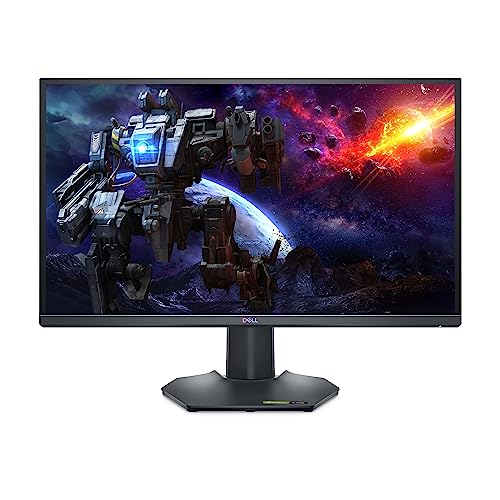
True Score
82822Experts
88126Customers
Absolutely Fresh
 SAVE $50$299.99$250.00
SAVE $50$299.99$250.00Snapshot
Reasons to Buy
- Great image quality
- Low Input lag
- High native refresh rate
Reasons to Avoid
- Subpar contrast ratio and HDR color gamut
- Okay response time
- No HDMI 2.1 and USB ports
Specifications

Aspect Ratio 16:9 
Available Inputs DisplayPort, HDMI 
Bluelight Filter Yes 
Built-In Speakers No 
Built-In Webcam No 
Curved Screen No Display Type LED 
Flicker Free Yes HDMI Inputs 2 HDR Format HDR10, HDR400 High Dynamic Range (HDR) Yes Max Resolution 2560 x 1440 
Panel Type IPS Refresh Rate 165 Hz 
Response Time 1 ms 
Rotating Screen Yes Screen size 27″ 
Sync Technology AMD FreeSync Premium, G-Sync, VESA Adaptive-Sync All Specs
Test Results
Brightness (nits) 432 Contrast Ratio (as ratio, x:1) 1,350 Color Gamut/Accuracy % (DCI P3 xy) 86 Color Gamut/Accuracy % (DCI P3 uv) 0 Color Gamut % (Adobe RGB Coverage xy) 82 Color Gamut % (sRGB Coverage xy) 100 All Retailers
- $250.00$300Save $50
Availability
In StockFree Shipping
No
Our Verdict
If you’re looking for a budget-friendly gaming monitor that doesn’t compromise performance, the Dell G2724D is an excellent option. With its low input lag of just 9 ms and a rapid response time of 4.3 ms, it caters well to the needs of gamers in fast-action scenarios where timing is everything. Although its peak brightness of 432 nits offers bright and clear imagery, it falls short of the Samsung Odyssey Neo G9’s exceptional 628.3 nits.
This monitor features complete sRGB color gamut coverage and a contrast ratio of 1350:1, presenting vibrant and accurate colors and enhancing the immersive quality of gaming sessions. Its 120 Hz refresh rate and 1440p resolution ensure smooth and detailed visuals, ideal for high-octane gaming and enjoying dynamic video content. Including both G-Sync and FreeSync Premium compatibility provides a fluid, tear-free experience with various graphics setups.
Beyond gaming, the Dell G2724D proves its versatility with features beneficial for content creation, work-related tasks, and general entertainment. Its combination of high brightness, color accuracy, and contrast makes it suitable for various activities, from video editing to binge-watching series. This monitor delivers satisfying performance across different uses, making it an all-around great option for those seeking quality on a budget.

Best Overall

Runner Up

Best Value

Best Budget

Best Mid-Range

Premium Pick
Samsung Odyssey Neo G9
The Samsung Odyssey Neo G9 is an exceptional 120 Hz monitor that excels for gaming and beyond with its top-tier specs and unmatched display quality at a premium price.
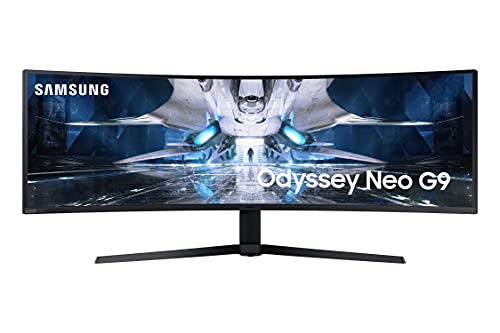
True Score
80814Experts
853kCustomers
Absolutely Fresh
 SAVE $900$2,499.99$1,599.99
SAVE $900$2,499.99$1,599.99Snapshot
Reasons to Buy
- Outstanding 240Hz maximum refresh rate
- Advanced Mini LED local dimming
- HDMI 2.1 inputs
- Excellent color gamut
- Outstanding 5120 x 1440 screen resolution
Reasons to Avoid
- Overly aggressive screen curvature
- Narrow viewing angles
- Variable refresh rate (VRR) issues at 60Hz
Specifications

Curved Screen Yes Display Type VA HDMI Inputs 2 HDR Format Yes Max Resolution 5120 x 1440 
Panel Type VA Refresh Rate 240 Hz 
Response Time 1 ms Screen size 49″ 
Sync Technology AMD FreeSync All Specs
Test Results
Brightness (nits) 628 Contrast Ratio (as ratio, x:1) 4,692 Color Gamut/Accuracy % (DCI P3 xy) 91 Color Gamut/Accuracy % (DCI P3 uv) 0 Color Gamut % (Adobe RGB Coverage xy) 86 Color Gamut % (sRGB Coverage xy) 100 All Retailers
- $1,599.99$2,500Save $900
Availability
In StockFree Shipping
No - $1,599.99$2,500Save $900
Availability
In StockFree Shipping
- $1,689.99$3,033Save $1,343
Availability
In StockFree Shipping
No - $2,199.99
Availability
In StockFree Shipping
No
Our Verdict
If you’re looking for a top-tier 120 Hz gaming monitor, the Samsung Odyssey Neo G9 delivers unparalleled performance in areas crucial to gamers at a premium price. With an ultra-low response time of 2.7 ms and minimal input lag at 8.9 ms, it’s ideally suited for high-speed gaming, ensuring fluid motion and impressively quick reaction to on-screen events. The monitor’s 120 Hz refresh rate and stunning 5120 x 1440 resolution, complemented by FreeSync support, promise a smooth and immersive gaming experience, especially in graphically intense games.
Its exceptional peak brightness of 628.3 nits and a remarkable contrast ratio of 4692:1—surpassing the Dell S3422DWG’s 3008:1—provide deep blacks and vibrant colors, making every scene pop. The impressive 99.6% sRGB color spectrum coverage ensures vivid and accurate colors, enhancing realism in games with dark and intricate visuals.
But the Odyssey Neo G9’s appeal extends beyond gaming. Its superior brightness, contrast, and color fidelity also make it a great choice for content creation, productivity tasks, and entertainment, such as watching movies or editing videos. The ultrawide screen and high resolution offer ample space for multitasking and creative projects, making it a versatile addition to any setup.
Overall, the Samsung Odyssey Neo G9 is not just a gaming powerhouse; it’s a multifunctional display that excels in gaming, entertainment, and professional applications, making it an excellent option for those who demand high performance in all aspects of their computer use.
Which Criteria Matters for Testing 120Hz Gaming Monitors?
By focusing on these criteria (2 required, 1 nice to have), anyone can quickly and easily compare these computer monitors and how they’ll perform. This helps you make an informed decision and purchase the best gaming monitor!
| CRITERIA | RANGE | REQUIRED | DEFINITION |
|---|---|---|---|
| Contrast Ratio | >1300:1 | Yes | The difference in brightness between the whites (lit sections) and blacks (dim or unlit sections) of a monitor panel. |
| Input Lag | < 15 ms | Yes | The time it takes for the monitor to register inputs from the user and process them as action. |
| Color Gamut (DCI P3 xy) | > 85% | No (Nice to have) | How much of the DCI P3 xy color gamut is covered by the monitor, which helps indicate color accuracy for HDR content, which includes certain movies. |
Our Trusted Data Sources
We looked at 110+ computer monitor reviewers and found that 33 are trustworthy (60%+ Trust Rating). The three we have listed below are our most trusted for computer monitors.
- Samuel Breton – Rtings, MuckRack
- Chris Eberle – Tom’s Hardware, LinkedIn
- Tony Hoffman – PC Mag, MuckRack
Interested in a comprehensive analysis of our data sources? We’ve got you covered. Below, you’ll find a detailed list of every computer monitor review website we’ve identified, organized by their respective Trust Ratings from highest to lowest. But we didn’t stop there. We’ve meticulously reviewed each publication and verified the data by checking whether the authors have bio links to MuckRack or LinkedIn. We’re committed to not only checking the facts but ensuring their veracity.
Computer Monitor Test Data & Results
1. Contrast Ratio (as ratio, x:1) Test Results
Contrast Ratio
> 1300:1
Acceptable range of performance
Definition: How bright the monitor will get, usually under specific testing conditions, like 10% windows (which means 10% of the screen is a white box.)
Units of Measurement: Ratio
Tools to Measure: Luminance meter or photometer or colorimeter
Why It’s Important:
Contrast ratio is how dynamic images are given detail and dramatic effect, with very dark areas appearing truly dark, while bright areas are bright and pop.
Contrast ratio is responsible for making images appear “dynamic” and “dramatic.” By having a good contrast ratio, a monitor is able to recreate dramatic differences between light and dark spots in scenes, images and games accurately.
At a minimum, we recommend a contrast ratio of 1300:1, as this will do a good enough job at allow for detail in dark scenes and images. If contrast ratio gets too low, the picture quality suffers, and the monitor performs worse across the board, no matter the lighting condition. By getting a monitor with a sufficiently high contrast ratio, you can ensure the picture quality doesn’t suffer, and dramatic scenes with stark shifts in lighting, whether they be in games or videos, are created as accurately as possible. When choosing a top-rated gaming monitor, consider a high contrast ratio to ensure dynamic visuals and immersive gameplay.
Contrast Ratio (higher is better)
2. Input Lag (ms) Test Results
Input Lag (ms)
< 15 ms
Acceptable range of performance
Definition: The amount of time it takes for a monitor to register an input from the user and display it.
Units of Measurement: Milliseconds (ms)
Tools to Measure: Input Lag Meter
Why It’s Important:
Input lag introduces artificial delay when gaming, which creates a mismatch between your reactions and on-screen action and creates frustration.
Input lag is more of a concern when it comes to gaming, but if you plan on using a monitor for a bit of gaming when you aren’t focused on productivity, editing or other tasks, lower values help improve responsiveness. High input lag means your actions take longer to register on the monitor, effectively introducing an artificial delay to your reactions.
It’s for this reason that we generally recommend an input lag under 15 ms. This ensures the delay that’s introduced has minimal impact on your reactions to what’s happening on screen. It’s important to note that a high input lag won’t have any real effect on anything that isn’t gaming, such as using the monitor vertically for coding, so it can be safely ignored if you don’t plan on gaming on your monitor.
Input Lag (in ms; lower is better)
3. Color Gamut/Accuracy % (DCI P3 xy) Test Results
Color gamut is responsible for making a monitor produce accurate colors when displaying a variety of content. The DCI P3 xy gamut is considered a “standard” gamut of sorts, and is used to help color grade films. Most HDR content will use this gamut at the very least (though other gamut exist) and it’s a commonly used gamut for films.
When it comes to a computer monitor, having a panel that covers at least 90% of the DCI P3 gamut means it’ll output accurate colors when watching HDR content and movies that use the gamut. If a monitor doesn’t cover enough of the gamut, it causes color inaccuracies and shifts the image quality. If you care about maintaining accuracy in the movies you watch so they look the way they were intended, this gamut needs to be properly covered. The best HDR monitors typically cover a significant portion of the DCI P3 gamut, ensuring vivid and accurate colors for an optimal viewing experience.
Color Gamut/Accuracy % (DCI P3 xy)
> 90%
Acceptable range of performance
Definition: The amount of the DCI P3 xy gamut that the monitor covers.
Units of Measurement: %
Tools to Measure: Colorimeter
Why It’s Important:
Color gamut coverage is important for ensuring that a monitor is able to accurately output colors. The DCI P3 xy gamut is responsible for making movies and HDR content look the way they were intended.
Color Gamut P3 XY (in %; higher is better)
Best 120Hz Gaming Monitors: Mistakes To Avoid
- Assuming Higher Refresh Rate Means Better: While a higher refresh rate can improve gaming smoothness, it’s not the only factor to consider. Other aspects, such as response time, panel type, and resolution, also play significant roles in overall performance. For example, when comparing 144Hz vs 75Hz gaming monitors, it’s important to understand that the higher refresh rate provides smoother visuals. Still, the overall gaming experience depends on how well other features, such as response time and resolution, meet your specific needs.
- Ignoring Panel Type and Response Time: Just like with 144Hz monitors, the panel type (TN, IPS, VA) and response time are crucial factors. TN panels typically offer the fastest response times but may sacrifice color accuracy and viewing angles compared to IPS or VA panels. Understanding refresh rate vs response time is important for gaming.
- Not Considering Resolution: While 120Hz monitors are often available in various resolutions, such as 1080p (Full HD), 1440p (QHD), and even 4K, choose a resolution that matches your graphics card’s capabilities and gaming preferences. The best 1080p gaming monitor offers a smooth gaming experience with higher refresh rates, ideal for competitive gaming on budget systems. For a more detailed and immersive experience, the top 4K gaming monitor delivers ultra-high resolution, which is perfect for gamers who prioritize visual fidelity and have powerful graphics cards.
- Overlooking Adaptive Sync Technology: Adaptive Sync technologies like AMD FreeSync and NVIDIA G-Sync can prevent screen tearing and stuttering, providing a smoother gaming experience. Ensure your monitor supports the adaptive sync technology compatible with your GPU. This can also help reduce issues such as a flickering monitor while gaming, which can occur due to synchronization problems between the monitor and the GPU.
The Best 120Hz Gaming Monitors Tests Compared
Product |
True Score
|
Brightness
|
Contrast Ratio
|
Color Gamut (DCI P3)
|
Color Gamut (sRGB)
|
Input Lag (ms)
|
Response Time (ms)
|
Reflections % | |
|---|---|---|---|---|---|---|---|---|---|
| 84 |
|
|
|
|
|
|
| $349.00 $400 $51 |
| 84 |
|
|
|
|
|
|
| $749.99 $1,000 $250 |
| 82 |
|
|
|
|
|
|
| $250.00 $300 $50 |
| 80 |
|
|
|
|
|
|
| $1,599.99 $2,500 $900 |

